

"Любопытство невозможно как следует удовлетворить, не дотронувшись рукой до заинтересовавшего тебя предмета. Невозможно определить, что он собой представляет, не пустив в ход пальцев: не помяв, не пощупав, не покрутив, не повертев. Всегда стремишься вдоволь потрогать и погладить. А тут этот отвратительный чешуйчатый мешок. Собрав все силы, ты пытаешься сорвать его с себя, но единственное, что удается, - напрягши спинной плавник и широко раскрыв жабры, выжать из себя зеленовато-желтое дерьмо..." (Кобо Абэ, "Человек-ящик")
Сквозь подернутый романтической дымкой поэтико-философский эпический облик Японии с годами все отчетливее проступает пульс огромных перенаселенных технологиями пост-индустриальных пейзажей - новой брутальной культуры с ее ответной декаданс-рефлексией на стремительно меняющийся облик окружающего мира. Образ, в своей сокрытости для понимания рождающий новые еретические ритуалы...
В восточной палитре странных, явившихся из ниоткуда звучаний каталога американского лэйбла Charnel Music - восходящих технологических иноваций Aube, неприступной превосходящей по мощи и напору Omoide Hatoba, пост-индустриальных племенных танцев Tokyo Dowser, электро-ураганного статического хаоса Merzbow, перманентной мутации эзотерических и ритмических граффити, три года назад я обнаружил впервые имя MELT-BANANA с их дебютным "Speak Squeak Creak", спродюсированным и записанным талантами Steve Albini и экстремального террориста Kazuyuki Kishino Null (NUX Organization), фронтмена японского проекта Zeni Geva, одновременно известного по многочисленным коллаборациям с мастерами мировой экспериментальной гитарной сцены. Их трэк "Party-Hat", обнаруженный позже на компиляции "The Miracle of Levitation" небольшого лэйбла из Каламазу Gentle Giant, продолжительностью... 45 секунд оставил странное ощущение какого-то дикого розыгрыша. Будучи проездом в Москве я напрасно пытался отыскать какие-то следы группы, слыша в ответ лишь недоуменное: "Невозможно... Андеграунд? в Японии?" Таким образом запущенный осенью 1995 по окончании их американского тура (c Mr.Bungle) стараниями все того же Аlbini и Jim O'Rourke (Illusion of Safety, Gastr del Sol) второй полноформатный "Scratch or Stitch", пересланный другом из Осаки, подоспел вовремя...
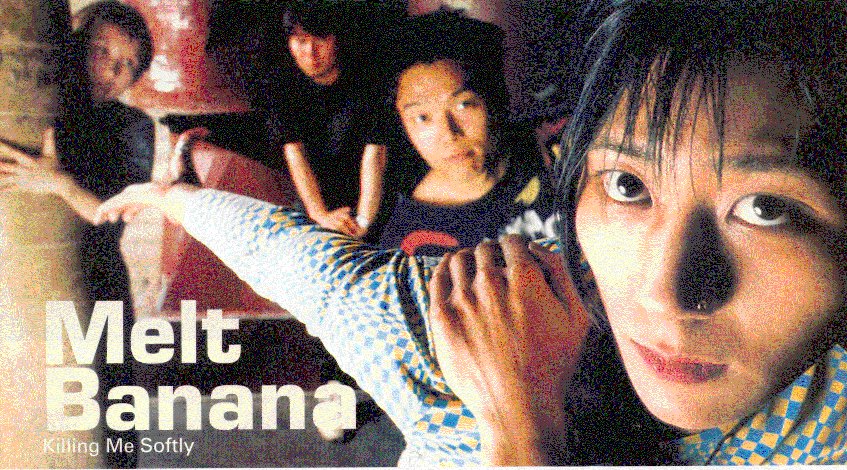
STRANGE FRUIT
"IMAGINE A HIGH-SPEED CAFFEINATED RHYTHM-DRIVEN YELP WITH SKYROCKETING GUITAR EMITTING SONGS AVERAGING ABOUT 2 MINUTES LONG. BIZARRE AND WONDERFUL" (Charnel Music, USA)
"MELT-BANANA REMINDS ME OF AN OVERPOWERED WIND-UP TOY HOLDING A MACHINE GUN THAT SHOOTS LIVE AMMO... GREAT STUFF" (Matt Kaufman, Exile Osaka, Japan)
 Истерическая конвульсивная гитарная игра, интерактивный
вокал на высоком регистре, fuck!, это музыка с другой планеты! Представьте себе
аллегорию образов, вдохновленных парками атракционов и саундтрэками к "мультяшкам",
дадаизм текстов в виде скороговорок, либо детских считалок о зверушках - слонах,
черепашках, резиновых игуанах, муравьях, рыбках, мышах, цыплятах, ...кетчупе
и печенье "Choco-Pie" ("...I just write down what's in my head", Yasuko), а
также нечленораздельных звуков импровизационной сцены (John Zorn) и цитат в
адской агонии раннего нью-йоркского _no wave_ MARS и DNA, плотную дымовую завесу
рванной монументальной ритм-секции и буйство режущей неустойчивыми замысловатыми
ритмами слух диссонирующей гитары с одержимым эксцентричным и высоко темпераментным
вокалом, в абсурдистско-экспрессивной манере рифмующей и балансирующей на грани
скрытых словесных символов и идиом ("Every song has a different color", Agata),
ироничность и сметение, оригинальность воображения, извращенность, сумасшествие
и рискованность, реальность и абсурд в широком спектре современной андеграунд-динамики
- от экспериментальных гитарных манипуляций и noise до highspeed и hardсore
punk trash. С присущей лишь японцам таинственной до маниакальности способностью
мутировать все выше перечисленное в далекий от определения гибрид Азиатской
и Западной культур, этот поистине убийственный коктейль продолжительностью обычно
не более 2 минут буквально сокрушает вас с первых же аккордов на протяжении
всех последующих... 22 (! - кассетный "Сactuses Come In the Flocks" содержит
30!) композиций. Переварив все выше изложенное вы получите исчерпывающее нововведение
в мир Расплавленного Бaнaнa. Get ready to hear the sounds!!! Go Go Godzilla.
Истерическая конвульсивная гитарная игра, интерактивный
вокал на высоком регистре, fuck!, это музыка с другой планеты! Представьте себе
аллегорию образов, вдохновленных парками атракционов и саундтрэками к "мультяшкам",
дадаизм текстов в виде скороговорок, либо детских считалок о зверушках - слонах,
черепашках, резиновых игуанах, муравьях, рыбках, мышах, цыплятах, ...кетчупе
и печенье "Choco-Pie" ("...I just write down what's in my head", Yasuko), а
также нечленораздельных звуков импровизационной сцены (John Zorn) и цитат в
адской агонии раннего нью-йоркского _no wave_ MARS и DNA, плотную дымовую завесу
рванной монументальной ритм-секции и буйство режущей неустойчивыми замысловатыми
ритмами слух диссонирующей гитары с одержимым эксцентричным и высоко темпераментным
вокалом, в абсурдистско-экспрессивной манере рифмующей и балансирующей на грани
скрытых словесных символов и идиом ("Every song has a different color", Agata),
ироничность и сметение, оригинальность воображения, извращенность, сумасшествие
и рискованность, реальность и абсурд в широком спектре современной андеграунд-динамики
- от экспериментальных гитарных манипуляций и noise до highspeed и hardсore
punk trash. С присущей лишь японцам таинственной до маниакальности способностью
мутировать все выше перечисленное в далекий от определения гибрид Азиатской
и Западной культур, этот поистине убийственный коктейль продолжительностью обычно
не более 2 минут буквально сокрушает вас с первых же аккордов на протяжении
всех последующих... 22 (! - кассетный "Сactuses Come In the Flocks" содержит
30!) композиций. Переварив все выше изложенное вы получите исчерпывающее нововведение
в мир Расплавленного Бaнaнa. Get ready to hear the sounds!!! Go Go Godzilla.
"No
sadness, no feeling
Does something stick into your mouth and ears?
Clockwork slaughter
We made the place to do so"
(Melt-Banana, "What do you slaughter next?", 1995)
What is Melt-Banana? Австралийская сладость, нечто сексуальное или ночной кошмар, парящий в небе? Метаморфозы великого подпольного фалического "дилдо" игры воображения Энди Уорхола с дебютной обложки легендарных Velvet Underground таким образом спустя более чем десятилетие обрели неожиданное продолжение в звучании и образах под знаком динамичной импровизационности freak-культуры (вероятно, одно из самых подходящих определений к творчеству Melt-Banana) в безумствованиях вокалистки Yasuko O., гитариста Agata, басистки Rika mm' и барабанщика Sudoh, Toshiaki.
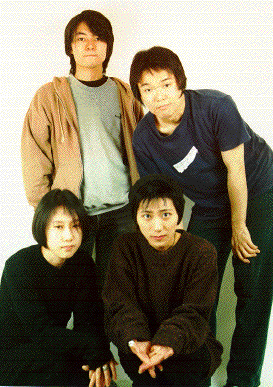 Melt-Banana стала
третьей группой в бушующей панк-карьере Yasuko ("...we tried to figure the easiest
way to play the instruments... when I started the band I just wanted to be something,
make something and be aggressive...", говорит она). Стартовав пять лет назад
в октябре 1992 в Токийском университете иностранных языков как трио, и уже в
ноябре отыграв на локальном фестивале импровизационной музыки ("живые" фрагменты
которого позже "всплыли" на кассетном релизе "Cactuses Come In Flocks"), они
выдумали себе это попсовое словечко в названии, декларируя отказ от ударных
и сделав гитару и бас более динамичными, а звуковую стратегию упругой, успешно
миновав акустическое звучание и обратившись к более жестким пост-индустриальными
корнями japanoise и одного из его ранних прородителей - Hijokaidan, с их более
структурированными гитарой, вокалом и нойз-генератором. До американского прорыва
на их первых выступлениях на родине можно было, по их собственному признанию,
насчитать пять-шесть зрителей ("... now that we are starting to get a little
famous it will change. In Japan the more you have money the more you can become
famous... Japanesse government sucks; the government never gives subsidies to
the arts"). Но им удалось заинтересовать своей музыкой Kishino-san (KK Null,
Zenigeva), а посещение их выступления почитаемым в Японии Stive Albini во время
тура Shellac вскоре сделало группу "yabai" (опасной, по выражению одного из
зрителей).
Melt-Banana стала
третьей группой в бушующей панк-карьере Yasuko ("...we tried to figure the easiest
way to play the instruments... when I started the band I just wanted to be something,
make something and be aggressive...", говорит она). Стартовав пять лет назад
в октябре 1992 в Токийском университете иностранных языков как трио, и уже в
ноябре отыграв на локальном фестивале импровизационной музыки ("живые" фрагменты
которого позже "всплыли" на кассетном релизе "Cactuses Come In Flocks"), они
выдумали себе это попсовое словечко в названии, декларируя отказ от ударных
и сделав гитару и бас более динамичными, а звуковую стратегию упругой, успешно
миновав акустическое звучание и обратившись к более жестким пост-индустриальными
корнями japanoise и одного из его ранних прородителей - Hijokaidan, с их более
структурированными гитарой, вокалом и нойз-генератором. До американского прорыва
на их первых выступлениях на родине можно было, по их собственному признанию,
насчитать пять-шесть зрителей ("... now that we are starting to get a little
famous it will change. In Japan the more you have money the more you can become
famous... Japanesse government sucks; the government never gives subsidies to
the arts"). Но им удалось заинтересовать своей музыкой Kishino-san (KK Null,
Zenigeva), а посещение их выступления почитаемым в Японии Stive Albini во время
тура Shellac вскоре сделало группу "yabai" (опасной, по выражению одного из
зрителей).
Они ненавидят половинчатость и мимикрию. Известные сегодня как беспорный лидер новой волны молодых групп японского "подземелья" от Токио до Чикаго, Cан-Франциско и Нью-Йорка, Вашингтона и Берлина, совершив четыре головокружительных и разрушительных акта по США в компании Smog, Red Krayola, US Marple, Mr.Bungle, Foetus, Jesus Lizard и tour de force по Европе, выступив в "джеме" с Jello Biafra и Butthole Surfers, отыграв в знаменитом нью-йоркском The Knitting Factory и по праву став третьей звездой "самурайского нашествия" на США после Boredoms и Shonen Knife, заручившись авторитетной поддержкой и покровительством Steve Albini, KK Null, Jim O'Rourke, Merzbow, Otomo Yoshihide и Yamatsuka Eye, выпустив два штурмовых альбома, ныне успешно распроданных по миру, расшатав стены не одного концертного клуба и приняв участие в невообразимом колличестве компиляционных авантюр, успешно выступив по возвращении из Америки в конце 1996 в местном клубе под заголовком "живого" проекта Сhaos@ и на проведенном недавно Gentle Giant в Японии авангардном форуме Music Merge Festival, прогрессирующее буйство этого экзотического токийского noise/no wave/grindcore фрукта, вобрав в себя нынешнее индустриальное звучание вконец свихнувшегося мира и ревущую мощь Big Black, Napalm Death и Painkiller Джона Зорна, диссонирующих Sonic Youth и "отвязных" Boredoms, сегодня не знает границ в своем превосходящем, бьющем через край энтузиазме.
И последнее, цитата из материала Cyndi Elliott в прошлогоднем апрельском номере "Alternative Press", которая, мне кажется, здесь вполне уместна: "...MAYBE WHEN THEY SPEAK IN JAPANESE, MELT-BANANA SAY MEAN THINGS ABOUT (...) JOURNALISTS AND THEIR STUPID QUESTIONS. BUT WHEN THEY PLAY, THERE ARE NO QUESTIONS!"
| "Headache
squats in your backpack Headache squats, it's your backslide What's kind of tipoffs you get? You try to keep up appearance Headless mob's sneaking around you Headless wob's sniffing at your shoe Close your backpack Hide your tipoff Run with headache to nowhere TIP & RUN" (Melt-Banana, "It's in the Pillcase", 1995) |
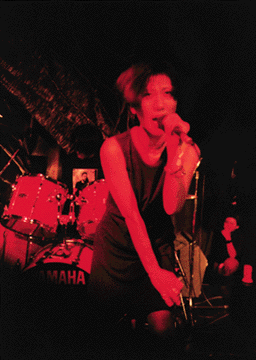 |
ACHTUNG BABY!: First of all, would like to ask you what do you knew about Russia before, and what is your impressions about this country now?
AGATA (A): Lenin Nikolai (?), Stalin, Communism finished, difficult language, Moscow, Seberia, Cold.
YASuKo (Y): Want to eat caviar!
Q: Well, some times ago Japan got a first virus of rock - not like a style, but more in global key, like any inner coordinal vision maybe - both musical and oppositional non-traditionalism/comformism' idea. Then Japan got a first local indie-labels movements (Alchemy, Japan Overseas...). Thanks to great activity of such well-known experimental/underground music revolutionaries and persons for Japanese radical scene like Masami Akita, Otomo Yoshihide, Akifumi Nakajima, Chu Ishikawa, Seiichi Yamamoto, Eye Yamatsuko, KK Null, Tatsuya Yashida, Maso Yamazaki, Jojo etc, last years the status of Japanese Underground had important growth over the World. Fact is that nowadays Japanese scene really have very serious support and interest from many of radical musicians and labels like for example Public Bath, Charnel Music (by the way last year released the first special Japanese underground music magazine "Ongaku Otaku"...), Gentle Giant, Skin Graft, Nipp Guitar, Relapse from US as well as Australian Extreme and Dorobo. But Europa, in my opinion, is still don't knows practically nothing about Japanese musical reality. What is the general cause, motives of it? Maybe Japan is too much closed country, if is that really so? Any comments, please...
A: I don't
think Japan is a "closed country", it is far from Europe, though. I'm not sure
how European people know about Japanese music situation. I feel You already
know about it a lot, even more than Japanese who like these kind of stuffs.
There's a zine called Exile Osaka and which report music situation in Osaka.
It is a good magazine. He also working for Thorazine from USA which
also report many Japanese music. So I guess Matt Kaufman knows good answer.
He knows much about Japanese music and he is a great person.
The reason we cannot play in Europe a lot, is because flight ticket is more expensive than it to USA. If we Japanese can be get paid for even only flight, many Japanese bands go to play in Europe, even they don't get paid for the show, I guess. So I don't think Japanese underground scene is closed. Anytime we can go there. Actually music situation in Tokyo is great. We can find almost any record if you can pay it. So, maybe secret of Japanese music scene is that there are so much information here in Tokyo. BUT it is difficult for Japanese bands to get good distribution in Europe. It is always through USA, I guess. But Ken Ishi has good deal in Europe, I guess, he is on major now, though. I think it is difficult to answer your question for all bands, like JAPANESE UNDERGROUND. Because it depends on the bands or labels. Teengenerate has good distribution in Europe, right? If Japanese independent bands are closed, it is because of language, not all Japanese can speak or write English. English and Japanese are absolutelly different. That's the reason, I guess.
Q: The thing is that I try to understand only what's the secret of your music (Japanese underground scene) in? How is happened that such country with very severe rules, traditions, inner social/political rituals and aesthetics, some years ago Japan was have such unexpected breakthrough with absolutelly untraditional musical forms and sonic rituals for classical Japan (if this _classical image_ is still really exist and isn't the game of some hot heads' imagination of foreigners)? Could you tell me, if your classical legendary life-stile is still have previous influence on your ordinary life now?
A: Not at all. Usually, we don't wear kimono on our ordinary life. There is no infuluence from classical legendary life-style. Almost the same, but there are small difference like we also use tatami or futon, take off shoes in the house or eat some different food.. etc... but it is not special difference. There are so much information, specially in Tokyo. I feel almost every music from all over the world can find here. So I see many musician from USA or Europe buy so many record here even it is more expensive than the price in their country. Maybe, if we wanted to play music different from these stuffs, it was only noise, MAYBE. And of course there are so many bands sound like Sonic Youth or Red Hot Chilli Peppers, or Oasis, or Beastie Boys ....etc....noise bands is still small part in Japanese music scene, maybe smallest.
Q: One other thing that is interesting me, it's connection between radical innovative (and often, very extremal) ideas of your post-modern culture (like, for example, a sound structural forms and musical harmonies' destruction, crazy nature-technological power and loud stormy frequencies, death drones, nerve dissonance, high-speedcore of today's aesthetics) and your personal inner vision -- child's vision or sexual abuse vision from some of Japanese musicians. Sexuality, rhythm and spirituality, all seems to be a components for your work... Could you tell me about sexual/animal magnetical energy with one head and child's world with other like about an important part of your creation? Do you feel this relation inner Melt-Banana' activity? Is that really so or it's product of my own excite imagination only?
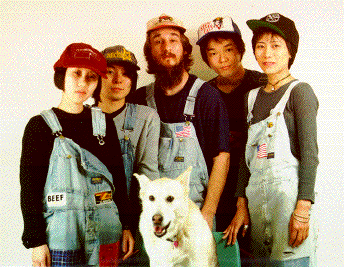 A: I am not sure that
it is only product of your imagination. There are a lot of child image in the
city, like KERO KERO KEROPPI or KITTY CHAN. These child character is not only
for child now. (But these character specially KITTY chan is also popular in
USA, too). And it is not only these 2 character. There are so many childish
character here and also Anime (Manga) is very popular here. (I think Japanese
animation is high quality, and grown ups also enjoy it a lot. Have you seen
Japanese animation? like Akira, or Eva? They are not like Disney ones at all
which is for peace and child-heart). You can see childish and sexual stuffs
in these stuffs easily. It is common for us. So these stuff might influence
Japanese.
A: I am not sure that
it is only product of your imagination. There are a lot of child image in the
city, like KERO KERO KEROPPI or KITTY CHAN. These child character is not only
for child now. (But these character specially KITTY chan is also popular in
USA, too). And it is not only these 2 character. There are so many childish
character here and also Anime (Manga) is very popular here. (I think Japanese
animation is high quality, and grown ups also enjoy it a lot. Have you seen
Japanese animation? like Akira, or Eva? They are not like Disney ones at all
which is for peace and child-heart). You can see childish and sexual stuffs
in these stuffs easily. It is common for us. So these stuff might influence
Japanese.
Q: OK, tell me... what do you think about today's condition and future for Japanese radical innovative scene?
A: Actually Japanese scene (which you say radical innovative scene) is not so big. It's like most people knows each other. 2-3 years ago, many people are interested in these music because of Boredoms. Many people came to the show of these kind of music and Major label spent money. It was like a boom. But I guess it finished and now people who really like these kind of stuffs only remained. I think it's almost same situation before that boom.
Q: How many people have a real interest to Japanoise/Japancore scene there?
A: Very small amount. Normal people have no chance to listen to and know about this kind of music.
Q: Do you have any support there?
A: ?.. Audience or friend? If friend see collaboration answer. If audience, we can not get 1000 people by ourselves like Boredoms. If promotion office or financial support you mean, nothing.
Q: What will be this future in your personal opinion?
A: This situation will not change much.
Q: When you started Melt-Banana what was your original goal or the basic idea or the basic spirit?
A: Yasuko wanted every equipment play different from other equipments. And wanted write POP music constructed by noise. (When we listened to Sonic Youth, we did not think it is noise music like many people said, we thought it is distorted pop music. It was like play pop music through distotion pedal. It is not music constructed by noise for us.(*we like Sonic Youth, don't misunderstand). Maybe it is the basic idea.
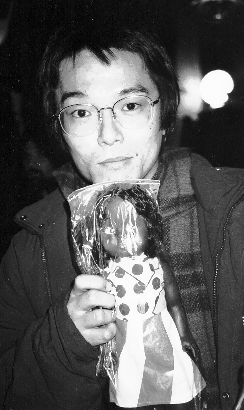 Q: By the
way, sorry, what's the significiance and/or meaning behind the strange name
Melt-Banana?
Q: By the
way, sorry, what's the significiance and/or meaning behind the strange name
Melt-Banana?
A: Melt-Banana is the name of Ice Cream which our friend found in Australia.
Q: Well, nowadays we can hear about many different contacts and joint collaborations between Eastern and Western musicians. But what about the differences between their musical perceptions and important detail peculiarities for you personally? You're also done a remarkable amount of collaborations... how does that normally work for you as far as initiating contact, the actual recording of the material, etc? Your own personal ego in working moments with them? Also any plans for collaborations in the works? Is that something you'd be interested in?.. What kind of creative individuality is most interested you in your joint collaboration with anyone? What about yourimpressions from your collaboration' experience with Steve Albini and KK Null (on the debut release "Speak Squeek Creak"), as well as with Jim O'Rourke and David Grubbs? How are you got an idea "Speak Squeek Creak" release?... Some ideas, sound-techniques, spirit, some important kind of professionalism or madness, what are you got from these people? How did you work with each of them? Who really influenced you?..
A: As for collaborations, KK Null and Steve are friend. We played with the band called Avalanch and KK Null was a guest player for the band. And he saw our show. And Yasuko asked Steve to come to the show when KK Null inveted SHELLAC to Japan. So he saw our show and Null said he could release our CD and Steve could record our 1st album. We were very happy. We met Jim when we first went to Chicago to record the first album and Jim introduced David. And when Red Crayola came to Japan, we opened for them and we met David again and he introduced Mayo Thompson, Tom Watson and John McEntire. And Red Crayola brought us to West Coast tour. And then when we played at San Francisco, we met Trey who is a guitar player of Mr. Bungle and he brought us to USA tour with Mr. Bungle. And met many more friends like our maneger now. Everything was going like this. Connected. And we study A LOT OF things from all of them. When we worked with Steve and Jim, they let us everything we wanted. And gave us great ideas like Steve's secret track remix on first album and Jim's many recording idea and song with him. They treated us as the same level as them. As for Elliot Sharp and Zeena Parkins, one Japanese label set up the collaboration. With Merzbow, one booking organizer thought Name, Melt-Banana and Merzbow, sounds similar (in Japanese) and sugested to do MERZ-BANANA. Violent Onsen Geisha is our friend. Basically collaboration is fun.
Q: How do you see you're personal and your sound developing over the next couple years?
A: Did many tours (2 times whole USA opening tour and 1 whole USA headlining tour and 1 tour in Europe), and wrote many songs (2 albums, 10-inch split EP, 11 EP including split EP and 12 or 13 compilation in 2,5 year). We saw many countries and met many people. We worked with independent label and major label, Japanese/ USA/ European booking agent, did many kind of shows like from no audience show to 2500 audience show, many instrumental and recording professional and non-professional who have ability like professional, all of that influenced us, I guess. Both good and bad change had come to each member and band after these things. It happens to some bands and some bands change more in shorter term, but we could not imagine these things when we just started the bands. I can't explain more.
Q: What helps you in your creation and its ideas to stay alive these days?
A: Go out to have fun.
Q: What do you think about any strange theory that Japaneses is really... extra-terrestrials, who long time ago came out from space on earth, and therefore Europeans/Americans will never understand them and their culture and magical spirit of life? :))
A: It's secret only Japanese knows.
Q: Thank you, Melt-Banana. Finally, that's all. Would love to wish you good luck to your activity and looking forward to your new releases as well as maybe our real meeting alive in Russia one day!
"Антипадение... Да, такой способ тоже возможен. Он означает падать не вниз, а, наоборот, к небу и утонуть в воздухе. А страх разбиться до смерти остается прежним. И, значит, удастся проснуться от этого также, как от падения на землю..." (Кобо Абэ, "Человек-ящик")
IGOR VAGANOV
Tokyo,
Japan - Russia
21 October 1997
(*) short version; original text plan to released in "Ongaku Otaku" mag (US), issue #3, so all questions and order via Mason Jones/Charnel House
*
Thanks to Thomas Deater (Gentle Giant Records, US), Matt Kaufman
* Credits: Wesley Joost, Cyndi Elliott
* Photo by Matt Kaufman (Exile Osaka, Japan), Stefan Malzkorn (Spex, Germany),
Ewolf (Alternative Press, US)
SELECTED WORKS:

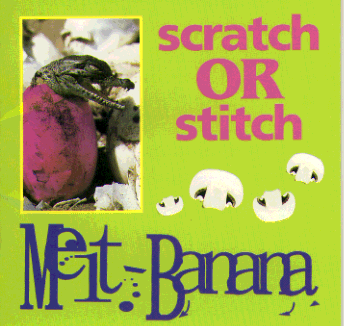




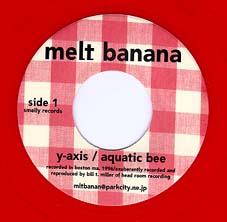
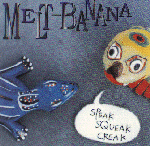

Cactuses Come
In Flocks (cassette only, Chocolate Monk Product, 1993)
Speak Squeak Creak (CD, NUX Organisation, 1994)
Scratch or Stitch (CD, Meldac, 1995)
Hedgehog (7" EP, Charnel)
It's in the Pillcase (7" EP, Skin Graft)
A Pile/Disposable Weathercock (7" EP, Gentle Giant, 1997)
Melt-Banana/Discordance
Axis (EP, 7", split)
Melt-Banana/God Is My co-Pilot (EP, 7", split, HG Fact)
Melt-Banana/Stilluppsteypa (LP, 10", split)
Melt-Banana/Target Shoppers (EP, split)
Melt-Banana/ Pencilneck (7" EP, split, Anti-Music)
v/a: The Miracle
of Levitation (CD, Gentle Giant, 1996)
v/a: Balls to the Wall (CD, dohb discs)
v/a: Tokyo Invasion Vol.I: Cosmic Kurushi Monsters (CD, Virgin)
v/a: Great Blue Thing (CD, Great Blue Thing)
v/a: Mi Caballito Chulo... !Como Io Quie Ro... (CD, ?Los Apson?)
v/a: 31 Bands Trash 31 Songs to Find the Way to Sesame Street (CD, Bun Length)
UPCOMING STUFF:
11th (EP,
Slap a Ham)
<no tittle> split with Xerobot (EP, Coat Tail)
<no tittle> split with Killout Trash (EP, Rodel)
v/a: <no tittle> (CD, Too Many Records)
v/a: <no tittle> (LP, Inner Psyche Productions)
v/a: <no tittle> (CD, KFJC radio)
v/a: <no tittle> (CD, Green Room)
v/a: <no tittle> (tape, Karim)
v/a: <no tittle> Beach Boys tribute (CD, Sony Music Entertainment)

CONTACT:
2-6-3 SHINKAWA, MITAKA-SHI, TOKYO 181 JAPAN
http://www.southern.com/southern/band/MELTB
http://www.cs.is.saga-u.ac.jp/laboratory/kusano/irman/bands.html